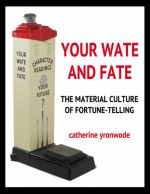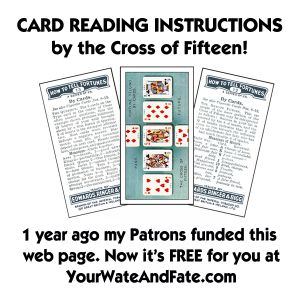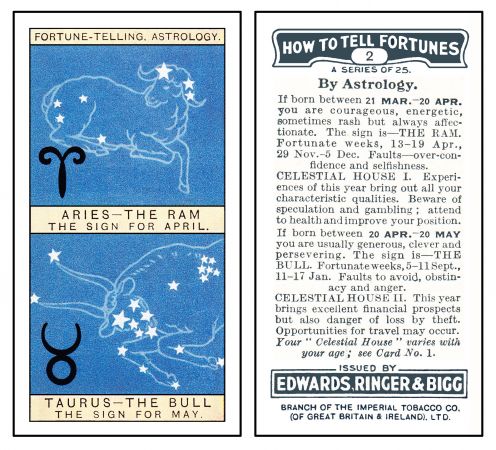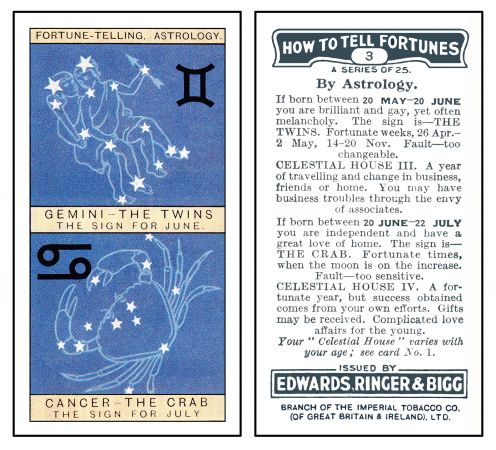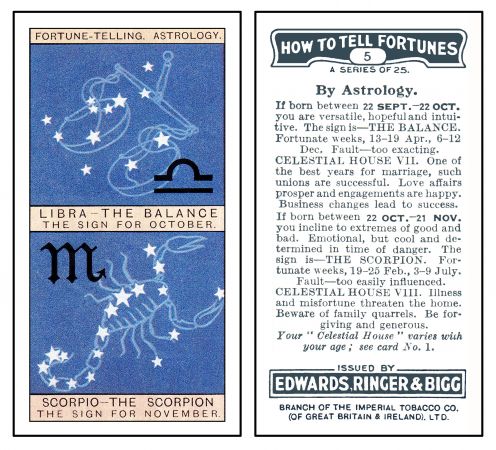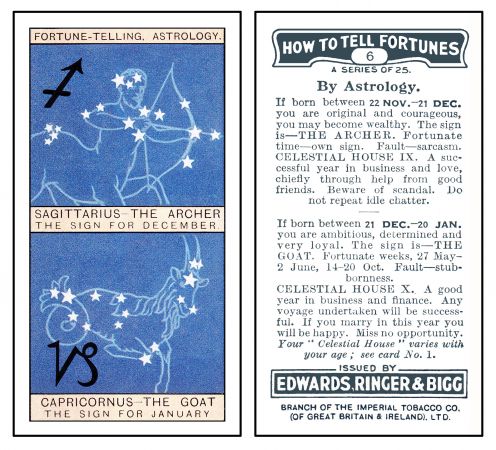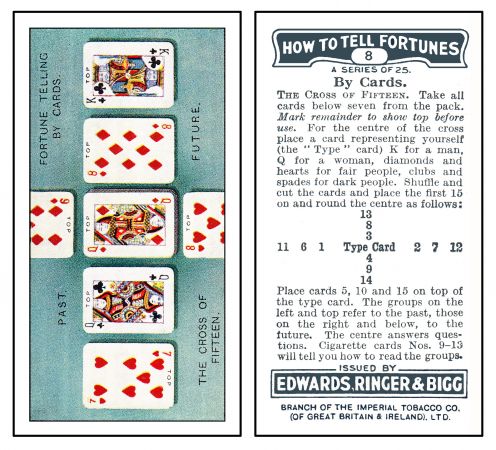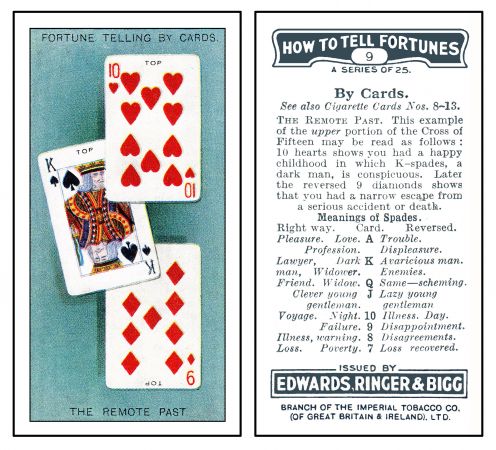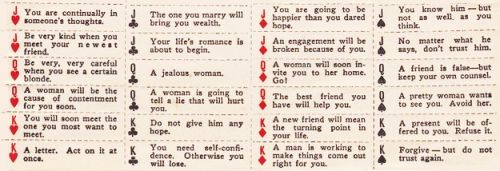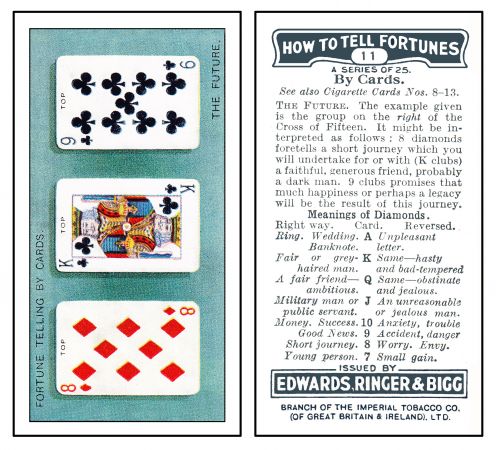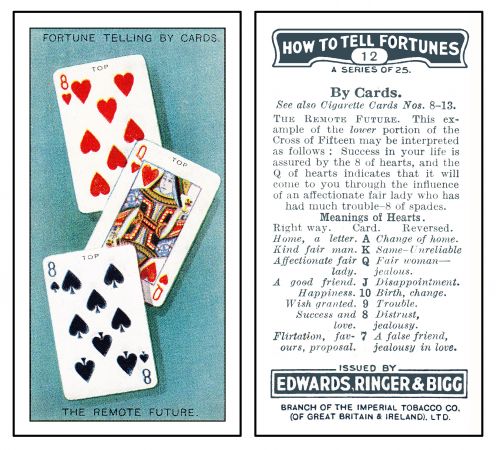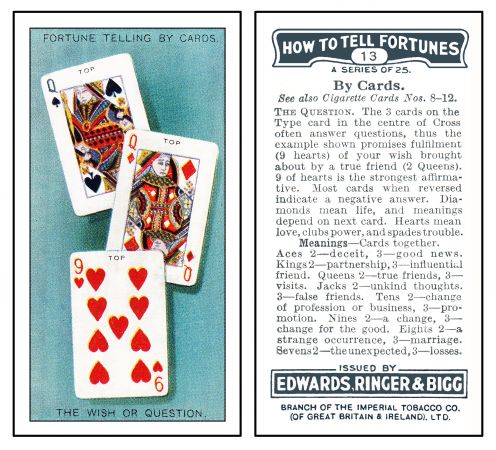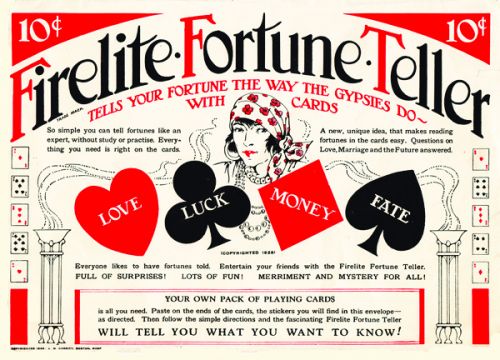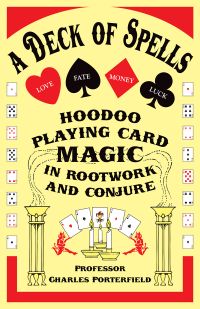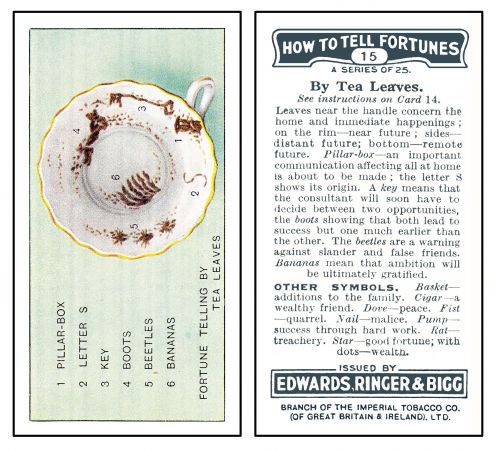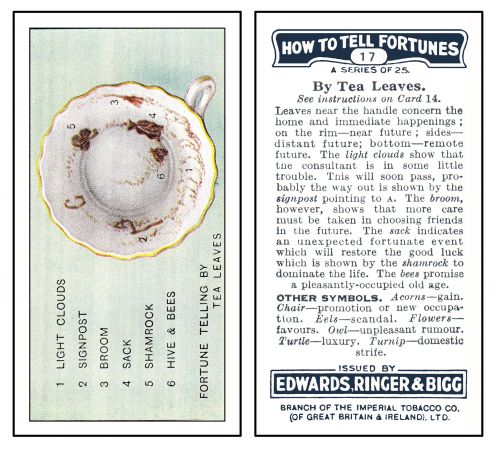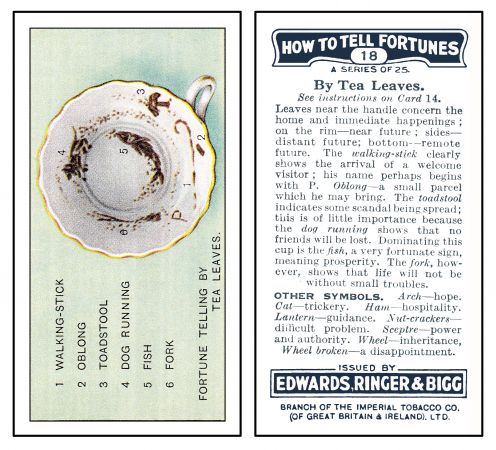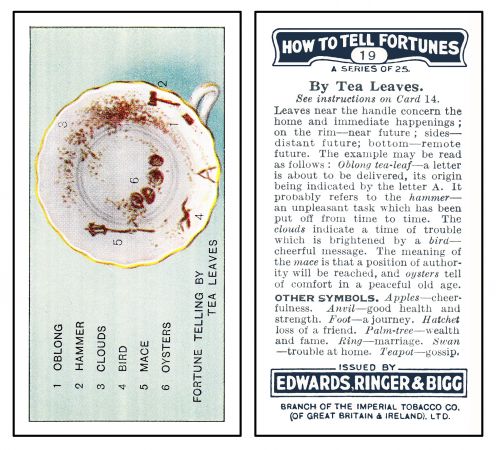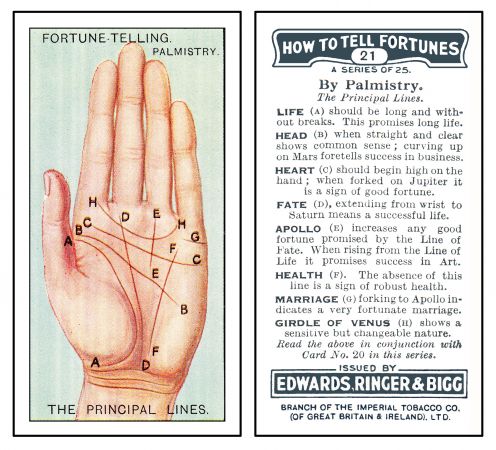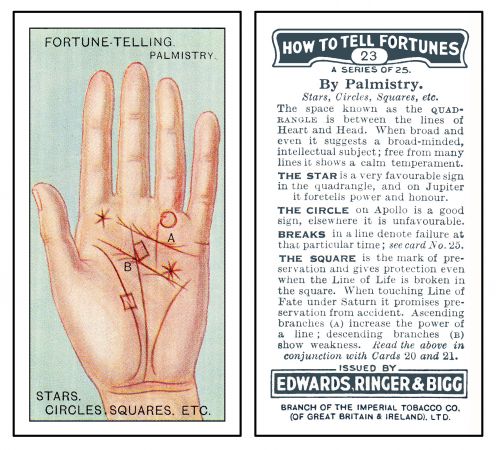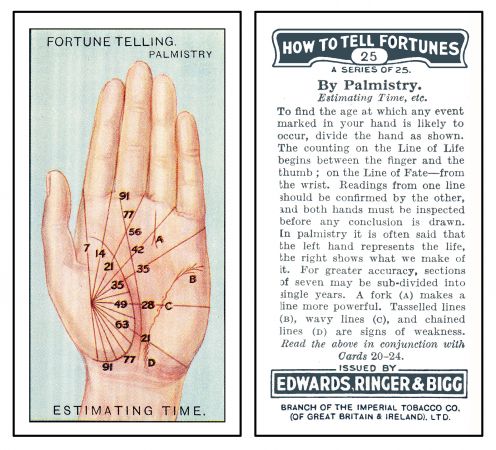Fortune Telling Cigarette Cards by Edwards, Ringer and Bigg
In this installment of "Your Wate and Fate," we take a sneak-peek look at an upcoming page that will eventually be on display to the public. As a Patreon supporter, you have access to the page one full year before the public does.
- Astrology: Patreon Release Date: October 21st, 2021
- Astrology: Public Release Date: October 21st, 2022.
- Cartomancy: Patreon Release Date: October 28th, 2021
- Cartomancy: Public Release Date: October 28th, 2022.
- Tasseomancy: Patreon Release Date: August 8th, 2022
- Tasseomancy: Public Release Date: August 8th, 2023.
- Palmistry: Patreon Release Date: September 28th, 2022
- Palmistry: Public Release Date: September 28th, 2023.
Please tell your friends that they can subscribe to my Patreon stream for $8.00 per month:
To discuss this and other Your Wate and Fate pages with me, join my private Patreon Forum here:
Support Your Wate and Fate
All of the material you have access to here — the instructive booklets, the nostalgic postcards, the boldly graphic ephemera, and all of the historical information researched and shared from the mind of the woman who is making it all happen — can easily fit into one 8 x 10 foot room in an old Victorian farmhouse, but you would never see it without the investment of the time it takes to produce such a site and the caloric input such a site requires in the form of food for the writer, graphic designer, and database manager, as well as the US currency needed to pay for the computers, software applications, scanners, electricity, and internet connectivity that bring it out of that little room and into the world. So, as you can see, this site is the darling of many, and it is growing at a rapid rate ... but although it is "free," there also is a cost. Your financial support underwrites this cost.
Each new web page or sample pdf is circulated to Patrons as an unpublished galley proof or advance copy. After one year access for Patrons, each web page will be released to the public, while book pages will be available to the public as printed books, and copies will be sent to Patrons who subscribe at the upper two tiers.
Patrons have access to a Private Patreon sub-forum within the Lucky Mojo Forum, and will be accorded special Red Star Avatar badges at the Forum.
Learn Fortune Telling While Smoking!
In decades past, most forms of divination, including astrology, cartomancy, tasseomancy, and palmistry were readily available to the public, and were practiced openly and without the stigma attached to them during the rise of Evangelical Christianity throughout the late 20th century. This wave of neo-Puritanism wiped away at least a century of familiarity with metaphysics, spiritualism, character analysis and fortune telling. Before the expansion of Evangelical culture, it was considered quite normal for common folks to be familiar with, and to practice, both folkloric and formal techniques of prophecy and prediction.
"How to Tell Fortunes," a set of 25 instructive cigarette trading cards, was issued by Edwards, Ringer & Bigg, a branch of the Imperial Tobacco Co. of Great Britain & Ireland, Ltd. in 1929.
Each pack of Edwards, Ringer & Bigg coffin nails came with one random card, and collectors would have to do a lot of smoking to gather a complete set before they went out of print and a new set of Edwards, Ringer & Bigg cards, such as"Sports and Games in Many Lands," came on the market. Lucky for card collectors — and aspiring fortune tellers — the hobby of collecting cigarette cards was so well developed in England that trading clubs and specialty shops sprang up where one could trade duplicates for elusive cards, and where non-smokers could purchase entire sets, still faintly reeking of unsmoked tobacco, in a not-unpleasant way.
"How to Tell Fortunes" proved to be so enduring in popularity that a replica set was issued in the 2002 by the Card Collectors Society. The replica set can easily be distinguished from the original because the text on the back of the repro cards is printed in maroon, not in the original dark greenish-blue.
Learn Fortune Telling by the Flash Card Method
This is one of the best sets of cards that teaches divination by the flash card method. In the briefest and most concise way possible, these cards present a complete introduction to four different methods of divining the future:
- Astrology: There are 7 cards in this sub-series. The first is an introduction to the names, glyphs, and dates of the zodiac signs; the next 6 contain two zodiacal signs and constellations per card.
- Cartomancy: 6 cards describe in full the popular old English method of reading playing cards by means of the traditional "Cross of Fifteen" layout.
- Tasseomancy: 6 cards present a crash course in tea leaf reading, with each study-cup containing exactly 6 numbered and named symbols, plus a brief list of other symbols, not shown, and their meanings.
- Palmistry: 6 cards delve into the basic aspects of palm reading by placement of the planetary mounds on the palm and by the naming and reading of the major and minor lines.
As was the norm for trading cards until the 1980s and 1990s, the author of these cards is uncredited, which is a shame, because it would have been nice to give due notice to the the way the writer organized the material. The text is both logically developed and very readable, providing a great amount of detail in a very small space. The artist too is uncredited, but appears to have been someone with fine classical training, which is most evident in the tea cup paintings, each of which is a miniature masterpiece.
Special thanks go out to my husband, nagasiva yronwode, for the complex job of scanning and colour-correcting these tiny 92-year-old treasures so that they can be viewed and enjoyed at a large size. We have worked together on graphic projects such as this since 1998, and his patience and precision have always amazed me.
Divination Instructions in 25 Lessons
And now, for your delight and edification, here are the Edwards, Ringer & Bigg Fortune Telling cards!
1. By Astrology (The Signs).
1. By Astrology (The Signs).
The sign you were born under, according to month of year, will be found among cards 2 - 7, with a description of the characteristics given by this sign. This cards shows lucky colours for those born under the various signs. A short forecast for the year, according to your present age, will also be found among cards 2 - 7. Find age in the key below, this refers to the "Celestial House" governing that year.
KEY
House I: 13, 25, 37, 49, 61, (73) - House VII: 19, 31, 43, 55, 67, (79)
House II 24, 36, 48, 60, 72, (84) - House VIII: 18, 30, 42, 54, 66, (78)
House III: 23, 35, 47, 59, 71, (83) - House IX: 17, 29, 41, 53, 65, (77)
House IV: 22, 34, 46, 58, 70, (82) - House X: 16, 28, 40, 52, 64, (76)
House V: 21, 33, 45, 57, 69, (81) - House XI: 15, 27, 39, 51, 63, (75)
House VI: 20, 32, 44, 56, 68, (80) - House XII: 14, 26, 38, 50, 62, (74)
The use of the Key to make forecasts will be played out in subsequent cards. For the convenience of those who don't smoke cigarettes and thus may expect a longer lifespan than indicated on these cards, i have taken the liberty of adding (in parentheses) the ages 73 through 84.
Astrologically, this first card is unusual in several respects.
The Colours: the "lucky colours" for the signs of the zodiac are idiosyncratic and do not accord well with either the chromatic circle of colours found in the neo-Hermetic systems of the 19th and 20th centuries (for instance, the Golden Dawn "King Scale" colours), nor do they accord with the colours generally assigned to planetary rulers, in the classical scheme of symbolism. To give but two examples, Aries, the first sign, is generally red, not pink, as is its ruling planet, Mars; and Libra, the seventh sign, is not associated with the colour black in any system known to me, as its ruler is Venus, which is verdantly green.
Melding Numerology With Astrology: The assignment of fortunes to ages is more often found in Numerology than in Astrology. (See my book, "The Secret of Numbers Revealed" for Dr. Roy Page Walton's numerological age forecasts as devised in 1914.)
Running Through the Houses Backwards: There is nothing inherently wrong with blending numerology with astrology to produce a novel system of fortune telling, and starting the First House with the age of 13 makes sense if one does not wish to foretell events for children aged 1 through 12 — but why did the author run the ages through the houses backwards (from I to XII to XI and so forth)? No explanation is given. Despite all of the oddities and unconventionalities in this first card, by creating a novel Numero-Astrological system of forecasts, the author has lifted simple Sun-sign Astrology from the predictability of character analysis (although that is included, of course) and brought forth a genuinely novel, albeit highly simplified, method of "cycling" through twelve years of fortunes by age. The result leads to forecasts much in the style of Asian or Chinese Astrology, which is based on the 12-year cycle of the planet Jupiter. So kudos to the whoever wrote the text for coming through on the promise that with these Astrology cards one could "Learn to Tell Fortunes."
2. By Astrology (Aries and Taurus).
2. By Astrology (Aries and Taurus).
If born between 21 MAR. - 20 APR. you are courageous, energetic, sometimes rash but always affectionate. The sign is — THE RAM. Fortunate weeks 13 - 19 Apr., 29 Nov. - Dec. Faults — over-confidence and selfishness.
CELESTIAL HOUSE I. Experiences of this year bring out all your characteristic qualities. Beware of speculation and gambling; attend to health and improve your position.
If born between 20 APR. - 20 MAY you are unusually generous, clever and persevering. The sign is — THE BULL. Fortunate weeks, 5 - 11 Sept., 11 - 17 Jan. Faults to avoid, obstinacy and anger.
CELESTIAL HOUSE II. This year brings excellent financial prospects but also danger of loss by theft. Opportunities for travel may occur.
Your "Celestial House" varies with your age; see Card No. 1.
3. By Astrology (Gemini and Cancer).
3. By Astrology (Gemini and Cancer).
If born between 20 May - 20 June you are brilliant and gay, yet often melancholy.
The sign is — THE TWINS.
Fortunate weeks, 26 Apr. - 2 May, 14 - 20 Nov.
Fault — too Changeable.
CELESTIAL HOUSE III. A year of travelling and change in business, friends o home. You may have business troubles through the envy of associates.
If born between 20 JUNE - 22 JULY you are independent and have a great love of home.
The sign is — THE CRAB.
Fortunate times, when the moon is on the increase.
Fault — too sensitive.
CELESTIAL HOUSE IV. A fortunate year, but success comes from your own efforts. Gifts may be received. Complicated love affairs for the young.
Your "Celestial House" varies with your age; see Card No. 1.
4. By Astrology (Leo and Virgo).
4. By Astrology (Leo and Virgo).
If born between 22 JULY - 23 AUG.
you are probably a leader. You are sympathetic, impulsive and very lucky.
The sign is — THE LION.
Fortunate times, 21 July - 23 Aug,. 27 Jan. - 2 Feb.
Fault — too easily depressed.
CELESTIAL HOUSE V. A year of opportunities. Excellent for marriage.
will overcome all difficulties. Beware of trouble in family.
If born between 23 AUG. - 22 SEPT.
you are generally successful but often proud.
The sign is - THE VIRGIN.
Fortunate weeks, 10 - 16 May, 28 Dec. - 3 Jan.
Fault — too critical.
CELESTIAL HOUSE VI. Caution should be the keyword of this year.
Be fair and just, and do not rely too much on others. Beware of accidents.
Your "Celestial House" varies with your age; see Card No. 1.
5. By Astrology (Libra and Scorpio).
5. By Astrology (Libra and Scorpio).
If born between 22 SEPT. - 22 OCT. you are versatile, hopeful and intuitive. The sign is — THE BALANCE. fortunate weeks, 13 - 19 Apr., 6 - 12 Dec. Fault — too exacting.
CELESTIAL HOUSE VII. One of the best years for marriage, such unions are successful. Love affairs prosper and engagements are happy. Business changes lead to success.
If born between 22 OCT. - 21 NOV. you incline to extremes of good and bad. Emotional, but cool and determined in time of danger. The sign is — THE SCORPION. Fortunate weeks, 19 - 25 Feb., 3 - 9 July. Fault — too easily influenced.
CELESTIAL HOUSE VIII. Illness and misfortune threaten the home. Beware of family quarrels. Be forgiving and generous.
Your "Celestial House" varies with your age; see Card No. 1.
6. By Astrology (Sagittarius and Capricorn).
6. By Astrology (Sagittarius and Capricorn).
If born between 22 NOV. - 21 DEC. You are original and courageous, you may become wealthy. The sign is — THE ARCHER. Fortunate time — own sign. Fault — sarcasm.
CELESTIAL HOUSE IX. A successful year in business and love, chiefly through help from good friends. Beware of scandal. Do not repeat the chatter.
if born between 21 DEC. - 20 JAN. You are ambitious, determined and very loyal. The sign is — THE GOAT. Fortunate weeks, 27 MAY - 2 JUNE, 14 - 20 OCT. Fault — stubbornness. CELESTIA: HOUSE X. A good year in business and finance. Any voyage undertaken will be successful. If you marry in this year you will be happy. Miss no opportunity.
Your "Celestial House" varies with your age; see Card No. 1.
7.By Astrology (Aquarius and Pisces).
7. By Astrology (Aquarius and Pisces).
If born between 20 JAN. - 18 FEB. you are artistic and have great influence over others. The sign is — THE WATER-BEARER. Fortunate weeks, 27 May - 2 June, 14 - 20 Oct. Fault — extravagance.
CELESTIAL HOUSE XI. A year of anxiety in business and home. You will overcome these difficulties with perseverance.
If born between 18 FEB. - 21 21 MAR. you are thoughtful and studious and probably artistic or musical. The sign is — THE FISHES. Fortunate weeks, 5 - 11 Aug., 12 - 18 Nov. Fault — lack of self-confidence.
CELESTIAL HOUSE XII. You will gain experience this year. Opposition from friends and others must be overcome in a resolute and independent spirit.
Your "Celestial House" varies with your age; see Card No. 1.
8. By Cards (The Cross of Fifteen).
8. By Cards (The Cross of Fifteen).
THE CROSS OF FIFTEEN. Take all cards below seven from the pack. Mark remainder to show top before use. For the centre of the cross place a card representing yourself (the "Type" card) K for a man, Q for a woman, diamonds and hearts for fair people, clubs and spades for dark people. Shuffle and cut the cards and place the first 15 on and around the centre as follows:
13
8
3
11 . 6 . 1 . Type Card . 2 . 7 . 12
4
9
14
Place cards 5, 10 and 15 on top of the type card. The groups on the left and top refer to the past, those on the right and below, to the future. The centre answers questions. Cigarette cards Nos. 9 - 13 will tell you how to read the groups.
The Cross of Fifteen: This card layout, "The Cross of Fifteen," dates back at least to the 19th century. It was described in highly simplified form by Professor P. R. S. Foli (Sir Cyril Arthur Pearson) under the name "The Wish with Fifteen Cards" in his book "Fortune Telling by Cards" in 1903 and was the best-known "cross" layout until the rising popularity of tarot cards brought us A. E. Waite's "Celtic Cross" in 1910. At one time it was certainly as popular as the Old Three Card Cut or the Method of Fifteen (three rows of 5 cards). However, unlike the Old Three Card Cut, it has fallen out of usage, which is unfortunate, because it is an excellent system and easily memorized. It begins with a pack of 32 cards numbered 7 through Aces high, otherwise known at a piquet pack, of which only 16 cards are used, 1 for the Type Card and 15 for the reading.
The Type Card: This is similar to what is called The Significator Card in some systems and the Man or Woman Card in others. Because the reading is done with playing cards, a court card is selected as the Type. Note now that there are actually 16, not 15 cards on the table — but the Type Card is not read; it is the marker or focus of the reading. In the description of the layout given above, it is said that the Type Card is "a card representing yourself," but, of course, if you are reading for a sitter, it is a card representing the sitter, not you.
The Eurocentric Complexion System: Due to the compressed nature of the text, i would like to note here that the assignments of Kings and Queens by skin complexion is Eurocentric, and is pretty vague. "Dark" and "light" can be taken to mean dark or light complexion with respect to genetic or ethnic expectations. In other words, a "light" African American person is "light," not "dark," while a "dark" Irish person is "dark" and not "light." Some readers approach the skin complexion assignments of the Kings and Queens by saying that Hearts are fair skinned with blond hair, Diamonds are fair skinned with brunette or auburn hair, Clubs are olive or tan skinned with brown or black hair, and Spades are brown skinned with black hair.
The Four Elements System: Another way to assign the Kings and Queens to specific types of people avoids complexion completely and is equally valid: Hearts are Water signs (Cancer, Scorpio, and Pisces), Diamonds are Earth signs (Taurus, Virgo, and Capricorn), Clubs are Fire signs (Aries, Leo, and Sagittarius), and Spades are Air signs (Gemini, Libra, and Aquarius).
Mark Remainder to Show Top Before Use: Marking each card at one end, as instructed on Card No. 8, need not be done with the word "Top" — but some mark must be made so that "right way" and "reversed" cards can be read appropriately in the system that follows. I recommend using a red Sharpie pen to run a line down the center of the edges of all the "Tops" and a black Sharpie pen to run a line down the center of the edges of all the "Bottoms." This can be seen, but it is far less distracting than writing the word "Top" on the cards.
9. By Cards (The Remote Past).
9. By Cards (The Remote Past).
See also Cigarette Cards Nos. 8 - 13.
THE REMOTE PAST. This example of the upper portion of the Cross of Fifteen may be read as follows: 10 hearts shows you had a happy childhood in which K-spades, a dark man, is conspicuous. Later the reversed 9 diamonds shows that you had a narrow escape from a serious accident or death.
Meanings of Spades.
Right way. Card. Reversed.
Pleasure, Love. Profession. A. Trouble. Displeasure.
Lawyer. Dark man. Widower. K. Avaricious man. Enemies.
Friend. Widow. Q. Same — scheming.
Cleaver young gentleman. J. Lazy young gentleman.
Voyage. Night. 10. Illness. Day.
Failure. 9. Disappointment.
Illness. Warning. 8. Disagreements.
Loss. Poverty. 7. Loss recovered.
Right Ways and Reversals: The marking of the cards at "Top" — as instructed on card No. 8 — allows for reverses to be read by memorizing the meanings given by suit, as shown on trading cards 9 - 12. In times past, one could buy playing card decks printed with meanings like these, and in 1928 a set of adhesive labels called the Firelite Fortune Teller was published by L. Gerrity in Boston, Massachusetts which, when glued onto the top and bottom of regular playing cards, allowed for their conversion into a fortune telling deck, without the need for memorization.
10. By Cards (The Immediate Past).
10. By Cards (The Immediate Past).
See also Cigarette Cards Nos. 8 - 13.
THE IMMEDIATE PAST. An example is given of the group on the left of the Cross of Fifteen. You lost a quiet and devoted friend, probably a dark lady (Q clubs), for a time, through the envy of a false friend (reversed 7 hearts). A fair or grey-haired gentleman brought you together again.
Meanings of Clubs.
Right way. Card. Reversed.
Success. Letter. A. Delay, bad news.
Kind dark man. K. Hard dark man.
A devoted friend. Q. Same — in trouble.
Young business man. J. Irresponsible youth.
Unexpected gift. Money. Journey. 10. Estrangement. Miser. Meanness.
Happiness. A legacy. 9. Obstacles. Troubles.
Trouble in love or business. 8. Difficulties disappear.
Gift. A parcel. 7. Dangerous task.
The Four Divisions of Time: One thing about this layout intrigues me, and that is its division of time into 4 segments rather than 3. Most card readers, especially those raised with the Old Three Card Cut, are habituated to thinking in terms of "Past, Present, and Future" readings, but here we have the Distant Past, the Recent Past, no Present at all, the Future, and the Remote Future.
As a reader, it took me a few practice runs to get the hang of that. In the end, i "got" it by thinking of the four time segments in relation to the old British tea leaf reading method, "Four turns to the bottom." Of course, in the tea cup, all four turns lead into the future, week by week, but the idea of a quaternary division of time suddenly clicked for me when i made that comparison.
The "missing" Present in this system is not actually missing, however. It comes up in "The Question," the pack of 3 cards described on cigarette card No. 13. To grasp this, think of the perennial client pleas, "What is he thinking about me right now?" or "Should i take this job?" — which are in the Present. These Present-centered queries are The Question.
11. By Cards (The Future).
11. By Cards (The Future).
See also Cigarette Cards Nos. 8 - 13.
THE FUTURE. The example given is the group on the right of the Cross of Fifteen. It might be interpreted as follows: 8 diamonds foretells a short journey which you will undertake for or with (K clubs) a faithful, generous friend, probably a dark man. 9 clubs promises that much happiness or perhaps a legacy will be the result of this journey.
Meanings of Diamonds.
Right way. Card. Reversed.
Ring. Wedding. Banknote. A. Unpleasant letter.
Fair or grey-haired man. K. Same — hasty and bad-tempered.
A fair friend — ambitious. Q. Same — obstinate and jealous.
Military man or public servant. J. An unreasonable or jealous man.
Money. Success. 10. Anxiety, trouble.
Good news. 9. Accident, danger.
Short journey. 8. Worry. Envy.
Young person. 7. Small gain.
A Little Bit of Showmanship: As depicted on cigarette trading card No. 8, above, the playing cards are all face up. In my experience, it is a bit more impressive, or showier, if all the cards except for the Type Card are first laid out face down, then turned over, one set of 3 at a time, to be read. You will start by turning the 3 cards of the Immediate Past over, one card at a time, and then read the narrative for that trio. Next will come the Remote Past, and so forth. As each set is turned and read, the cards are left in face-up position. The last 3 cards, the Question, may be laid in a row right in front of the sitter, emphasizing their nearness to her and their special importance. If the sitter has been read for in the past and knows to look for the 9 of hearts, handling the cards in this way will help keep her in suspense, hoping for the Wish card to show, right up until the very end if need be.
The Cross of Fifteen layout is quite large. If table-space is at a premium you have two options. First, you can use a Patience or mini-deck. Second, instead of building out the four arms of the cross by setting the Past and Future cards next to one another, you can stack them, as you do for the Question stack. The result is still a cross, but it is much more compact.
This compressed version of the layout was called "By Fifteen" in Minetta's 1890 book "What the Cards Tell," and was described and illustrated as "The Star of Fifteen" in Charles Platt's undated, circa 1900 book "Card Fortune Telling,"
12. By Cards (The Remote Future).
12. By Cards (The Remote Future).
See also Cigarette Cards Nos. 8 - 13.
THE REMOTE FUTURE. This example of the lower portion of the Cross of Fifteen may be interpreted as follows: Success in your life is assured by the 8 of hearts, and the Q of hearts indicates that it will come to you through the influence of an affectionate fair lady who has had much trouble — 8 of spades.
Meanings of Hearts.
Right way. Card. Reversed.
Home. A letter. A. Change of home.
Kind fair man. K. Same — unreliable.
Affectionate fair lady. Q. Fair woman — jealous.
A good friend. J. Disappointment.
Happiness. 10. Birth, change.
Wish granted. 9. Trouble.
Success and love. 8. Distrust, jealousy.
Flirtation, favours, proposal 7. A false friend, jealousy in love.
The Mathematics of It All: Okay, now, pausing here before the final lesson on card reading, let's review. You have been given a complete layout system for playing cards, using 8 cards per suit -- A-K-Q-J-10-9-8-7. There are four suits, which results in a piquet pack of 32 cards, and each card is seen in two aspects, "right way" and "reversed," which brings the total number of memorized card meanings to 64 ... so far. But there's more.
13. By Cards (The Question).
13. By Cards (The Question).
See also Cigarette Cards Nos. 8 - 13.
THE QUESTION. The 3 cards on the Type card in the centre of the Cross often answer questions, thus the example shown promises fulfillment (9 hearts) of your wish brought about by a true friend (2 Queens). 9 of hearts is the strongest affirmative. Most cards when reversed indicate a negative answer. Diamonds mean life, and meanings depend on next card. Hearts mean love, clubs power, and spades trouble.
Meanings — Cards together.
Aces 2 — deceit, 3 — good news.
Kings 2 — partnership, 3 — influential friend.
Queens 2 — true friends, 3 — visits.
Jacks 2 — unkind thoughts, 3 — false friends.
Tens 2 — change of profession or business, 3 — promotion.
Nines 2 — a change, 3 — change for the good.
Eights 2 — a strange occurrence, 3 — marriage.
Sevens 2 — the unexpected, 3 — losses.
The Cards Together: The extra meanings of "The Cards Together" by doubles or triples are to be interpreted only with respect to the three-card arrays in which these doubles or triples occur. In other words, having 3 Queens show in the layout is possible for a female sitter, and a male sitter could even have 4 Queens showing — but it is not the layout as a whole that is being scanned for "Cards Together." Rather, they must appear by doubles or triples in one of the four divisions of time or in the Question stack. Only then is their extra meaning invoked — and only in regard to the area in which they occur.
The Wish: An obvious Britishism appears in the Cross of Fifteen, and that is "the Wish." The Wish is so central to this reading method that, as i mentioned above, Professor P. R. S. Foli (Sir Cyril Arthur Pearson) called his simplified version of it "The Wish with Fifteen Cards" when he included it in Chapter XVI of his 1903 book "Fortune Telling by Cards." That chapter was titled "Your Heart's Desire" and it contained a total of six different Wish layouts, including "The Four Aces" and "The Wish in Seven Packs."
The Wish also figures into British tea leaf reading, where an extra cup reading is made on "the Wish," apart from whatever images are seen and interpreted in the first cup of leaves. In tasseomancy, finding three dots in a straight row indicates that the Wish will come true. Here, in the Cross of Fifteen, as in all British cartomancy layouts, the Wish card is the 9 of hearts, and its appearance in the reading signifies that the Wish will be granted.
Because you will start with a pack of 32 cards and use only 16, one of which is a court card (the Type Card) which cannot be the 9 of hearts, there will be just under a 50-50 chance that the 9 of hearts will appear and the sitter's Wish will be granted soon, may possibly be granted in the future or was granted in the past. Don't tell this to the sitter; it is something for you, the reader, to know and see as you deal out the 15 cards.
After laying out the Type Card, you may instruct the sitter to cut the remaining 15 cards once with her left or "off" hand while she makes a silent, secret wish or thinks of her heart's desire. Then start the layout, as explained on Card No. 8, saying, as you lay out the cards, "While i am setting out the cards, i want you to continue to think of your special wish, your secret wish, your heart's desire — and do not tell me what it is."
To a reader, the Wish is a specific but secret hope that the sitter has in mind, has not told you, and which you will not ask about. The sitter's silence about the Wish is just as obligatory in British tea reading and British cartomancy as it is when a British child blows out his birthday candles and makes a Wish, because, as the parents always say, "Don't tell your Wish or it won't come true."
In both Minetta's and Platt's descriptions of this layout, the 9 of hearts is the Wish Card, but Minetta goes one step further and says, "Should the Nine of Hearts come out in the wish-pack, you will for a certainty have your wish. The Nine of Spades in the wish-pack — the wish will never be obtained." Thus Minetta adds a definite "No" to the reading, which is more declarative than the weak "No" derived from the fact that the Wish cards simply fails to show up.
In this card reading the Wish is only referred to obliquely.
- If the 9 of hearts is present in either of the Past packets, you are to say, "A Wish that you made came true in the past."
- If the 9 of hearts is present in either of the Future packets, you are to say, "The Wish that you made may come true in the future and you can make that wish again at our next reading."
- If the 9 of hearts is present in the Question packet, you are to say, "Your Wish is sure to be granted."
- If the 9 of hearts is not present, you are to say, "The Wish that you made will probably not come true."
- If the 9 of spades is present in the Question packet, you are to say, "Your Wish will not come true."
- If both the 9 of hearts and the 9 of spades are present together in the Question packet, you are to say, "You will get your wish and live to regret it."
This information is conveyed to the sitter without ever asking about or directly naming the Wish.
Technically, because the Type Card can never be the Wish Card, there are only 31 cards in play for the Wish. The Wish has 6:31 odds of appearing in the past, 6:31 odds of appearing in the future, 3:31 odds of appearing in answer to the Question, and 16:31 odds of not appearing at all. If you decide to use Minetta's 9 of spades in the Question pack as the Wish-denier, you have 3:31 odds that the wish will be denied.
More Math: A piquet deck of 4 suits times 8 cards times 2 positions ("right way" and "reversed"), gives us 64 meanings, plus the reconsiderations of our 8 cards by pairs and triplets (not by suit) — which means 16 more meanings to memorize.
This brings us to a total of 80 meanings, which is proof enough to me that the Cross of Fifteen is a professional card-reader's layout, not a hobby layout for dabblers.
I have written before, in my book "Throwing the Bones," about the mathematical structures that undergird various systems of bone, nut, and shell sortilege. In particular, when describing the British system of reading dominoes, i wrote:
"Now, lest anyone dismiss this domino sortilege oracle as a trivial parlour game, please consider that the reader is required to memorize 69 different meanings (7 suits, plus 49 pairs, plus 13 spot-totals) — which puts the Gypsy Domino Bone Oracle about halfway in complexity between a reading with 52 poker cards and a reading with 78 tarot cards. In other words, if you want to read the dominoes, be prepared to spend some time in study before you take your Gypsy caravan on the road."
To place our card layout in context, therefore, with its 80 meanings, the Cross of Fifteen requires more memorization than a 52-card poker deck reading with no reverses, a domino reading with 69 tile options, or a 78-card tarot deck reading with no reverses, but it is less complex than either of the card readings with reverses (104 and 156 meanings, respectively).
A Bonus!: I'm sure that some of you got caught up when i mentioned the Firelite Fortune Teller adhesive strips manufactured in 1928 by L. Gerrity of Boston, Massachusetts. Since "it's all ephemera" here, let me take a few more pixels to show you the original envelope that these were packaged in, as a bonus:
You may be happy to know that these strips and their envelope were reprinted by the B. Shackman company in the 1990s. The reproductions are more easily found and not as costly as the rare originals, should you wish to acquire a set.
I am sure that many of you will recognize the Firelite Fortune Teller envelope as the inspiration for my graphic design for the cover of the book "A Deck of Spells" by Professor Charles Porterfield, published by Lucky Mojo in 2015. The actual cover was executed by my talented colleague, Grey Townsend.
$12.00
BOO-GRI-ADOS
In Conclusion: In my opinion, the Cross of Fifteen is an under-appreciated and under-utilized system of cartomancy. I recommend it to anyone who likes to experiment with layouts that look good on the reading table and produce meaningful readings for sitters by —
- Delivering a general reading (the two Pasts and the two Futures),
- Answering from 1 to 3 specific questions (by means of the 3 Question cards),
- Telling whether the Wish will be granted (if the 9 of hearts is present or not) or if it is to be denied (if the 9 of spades comes out in the Wish pack), and
- Supplying extra layering with special meanings for Cards Together, that is, card numbers that appear more than once, and are interpreted with respect to the three-card arrays in which they occur.
That is quite a lot of card reading theory to be packed into a mere 6 cigarette cards, don't you think? I have to give a lot of credit to the author for crafting such a solidly compressed, yet easily unpacked, layout, one which would take most authors at least 12 book pages to explain.
14. By Tea Leaves (Instructions).
14. By Tea Leaves (Instructions).
Hold the cup in the left hand, swing it quickly three times from left to right and then invert it on the saucer. Leaves near the handle concern the home and immediate happenings; on the rim — near future; sides — distant future; bottom — remote future.
The cup shown here may be interpreted thus:
1. Pincers — a trifling difficulty or pain, perhaps toothache, is troublesome, and
2. The Hour-Glass points to an urgent duty which remains unperformed.
3. Pipe — a visit from an intimate friend will soon be received,
4 whose name probably begins with R.
5. The Steeple shows that ambitions realized, although late in life,
6. will bring a happy (Pine Trees) and tranquil old age.
OTHER SYMBOLS.
7. Arrow — unpleasant letter.
8. Buoy — hope.
9. Gate — opportunities.
10. Rose — good luck and love.
11. Swallow — pleasant journey.
Further symbols on Cards 15-19.
Additional Basic Information: These tasseomancy instructions are quite compressed to fit the size of the card, so some expansion is in order. The swirling and inversion of the cup is generally called "tossing the cup." As noted by the author, most readers signify the handle as "home" and the opposite to it as "away" or distant places. Moving clockwise from the handle, symbols between "home" and "away" are moving away from the sitter, and symbols between "away" and "home" are coming toward the sitter. The rim is the present week, two levels spiraling clockwise around the sides indicate the next fortnight, and the bottom of the cup is the remote future. This system of measuring time in the cup is called "four turns to the bottom."
There are 6 pictured images and 5 described images on this card, for a total of 11.
15. By Tea Leaves.
- 15. By Tea Leaves.
See instructions on Card 14.
Leaves near the handle concern the home and immediate happenings; on the rim — near future; sides — distant future; bottom — remote future.
1. Pillar-box — an important communication affecting all at home is about to be made;
2. the letter S shows its origin.
3. A Key means that the consultant will soon have to decide between two opportunities,
4. the Boots showing that both lead to success but one much earlier than the other.
5. The Beetles are a warning against slander and false friends. <br6. Bananas mean that ambition will be ultimately gratified.
OTHER SYMBOLS
7. Basket — additions to the family.
8. Cigar —a wealthy friend.
9. Dove — peace.
10. Fist — quarrel.
11. Pump — success through hard work.
12. Rat — treachery.
13. Star — good fortune;
with 14. Dots — wealth.
Commentary: A "Pillar-box" is an old English term for a specific form of letter box or public mail box; once common on the streets, it is now a rarity, as most mail is digital.
There are 6 pictured images and 8 described images on this card, for a total of 14.
16. By Tea Leaves.
- 16. By Tea Leaves.
See instructions on Card 14.
Leaves near the handle concern the home and immediate happenings; on the rim — near future; sides — distant future; bottom — remote future.
1. Much of the success seen in this cupis due to the Anchor — good friends.
2. The Oblong and
3. Circle mean that a present or sum of money is coming,
4. its origin being indicated by the letter E.
5. The Dancer shows good fortune and a great capacity for enjoyment.
6. The only ominous sign in this very fortunate cup is the pair of Scissors; this is a warning against quarrelling with good friends.
OTHER SYMBOLS.
7. Antlers — accidents.
8. Branch — a birth in the family.
9. Ivy — loyal friends.
9. Ivy Leaf — devoted lover.
10. Oil-can — worry.
11. Rabbit — timidity and hesitation.
12. Sextant — knowledge.
13. Tower — opportunity.
14. Worms — secret enemies.
There are 6 pictured images and 8 described images on this card, for a total of 14.
17. By Tea Leaves.
- 17. By Tea Leaves.
See instructions on Card 14.
Leaves near the handle concern the home and immediate happenings; on the rim — near future; sides — distant future; bottom — remote future.
1. The light Clouds show that the consultant is in some little trouble. 2. This will soon pass; probably the way out is shown by the Signpost pointing to A.
3. The Broom, however, shows that more care must be taken in choosing friends in the future.
4. The Sack indicates an unexpected fortunate event which will restore the good luck which is shown by
5. The Shamrock to dominate the life.
6. The Bees promise a pleasantly-occupied old age.
OTHER SYMBOLS
7. Acorns — gain.
8. Chair — promotion or new occupation.
9. Eels — scandal.
10. Owl — unpleasant rumour.
11. Turtle — luxury.
12. Turnip — domestic strife.
There are 6 pictured images and 6 described images on this card, for a total of 12.
18. By Tea Leaves.
- 18. By Tea Leaves.
See instructions on Card 14.
Leaves near the handle concern the home and immediate happenings; on the rim — near future; sides — distant future; bottom — remote future.
1. The Walking-Stick clearly shows the arrival of a welcome visitor; his name perhaps begins with P.
2. Oblong — a small parcel which he may bring.
3. The Toadstool indicates some scandal being spread;
4. this is of little consequence because the Dog Running shows that no friends will be lost.
5. Dominating this cup is the Fish, a very fortunate sign, meaning prosperity.
6. The Fork, however, shows that life will not be without small troubles.
OTHER SYMBOLS
7. Arch — hope.
8. Cat — trickery.
9. Ham — hospitality.
10. Lantern — guidance.
11. Nut-Crackers — difficult problem.
12. Sceptre — power and authority.
13. Wheel — inheritance. —
14. Wheel, Broken — a disappointment.
There are 6 pictured images and 8 described images on this card, for a total of 14.
19. By Tea Leaves.
- 19. By Tea Leaves.
See instructions on Card 14.
Leaves near the handle concern the home and immediate happenings; on the rim — near future; sides — distant future; bottom — remote future.
The example may be read as follows:
1. Oblong Tea-leaf — a letter is about to be delivered, its origin being indicated by the letter A.
2. It probably refers to the Hammer — an unpleasant task which has been put off from time to time.
3. The Clouds indicate a time of trouble which is
4. brightened by a Bird — cheerful message.
5. The meaning of the Mace is that a position of authority will be reached,
6. and Oysters tell of comfort in a peaceful old age
OTHER SYMBOLS
7. Apples — cheerfulness.
8. Anvil — good health and strength.
9. Foot — a journey.
10. Hatchet — loss of a friend.
11. Palm-Tree — wealth and fame.
12. Ring — marriage.
13. Swan — trouble at home.
14. Teapot — gossip.
There are 6 pictured images and 8 described images on this card, for a total of 14.
A small book: There are 36 pictured tea leaf images and 43 described tea leaf images — for a grand total of 79 tea reading symbols on a mere six cards, which is a mighty impressive feat.
20. By Palmistry.(The Mounts)
- 20. By Palmistry.
The Mounts.
VENUS well-developed indicates good health and love of beauty.
JUPITER if prominent shows ambition and desire for power.
SATURN is not often developed; in such cases it denotes melancholy. Small development indicates prudence, preference for solitude, and earnestness in work.
APOLLO reveals a sunny nature and appreciation of beauty in art and literature. In excess it denotes extravagance.
MERCURY well-developed, is a sign of wit, intelligence, and love of change.
MARS development of these mounts shows courage and presence of mind.
LUNA high development indicates a romantic and sympathetic nature.
Our classically literate author prefers to call the Sun Apollo and the Moon Luna.
21. By Palmistry. (The Principal Lines.)
- 21. By Palmistry.
The Principal Lines.
LIFE (A) should be long and without breaks. This promises long life.
HEAD (B) when straight and clear shows common sense; curving up on Mars foretells success in business.
HEART (C) should begin high on the hand; when forked on Jupiter it is a sign of good fortune.
FATE (D), extending from wrist to Saturn means a successful life.
APOLLO (E) increases any good fortune promised by the Line of Fate. When rising from the Line of Life it promises success in Art.
HEALTH (F). The absence of this line is a sign of robust health.
MARRIAGE (G) forking to Apollo indicates a very fortunate marriage.
GIRDLE OF VENUS (H) shows a sensitive but changeable nature.
Read the above in conjunction with Card No. 20 in this series.
For a deeper dive into the lines of the hand, also see the Palmistry Cigarette Cards by Major Drapkin and Company, which deal only with the lines.
22. By Palmistry.
- 22. By Palmistry.
A Fortunate Hand.
In the hand shown good fortune predominates. Ascending branches are found on many lines and by the side of (A) a sister line is seen strengthening the Line of Life. A square, the mark of preservation, protects from a danger threatening in middle age.
The powerful Line of Head (B) touching (A) indicates energy and the ability to control others; the fork on Luna shows a literary talent.
The clear Line of Heart (C) shows a life fortunate in love.
In the Line of Fate (D), rising from the wrist and reaching Saturn, is seen great distinction.
The Marriage Line (E) shows a happy and wealthy union — age 25-30.
Apollo (F) increases the success given by (D).
Triple bracelets (each equals 30 years) promise long life.
Read the above in conjunction with Cards No. 20 and 21 in this series.
23. By Palmistry.
- 23. By Palmistry.
Stars, Circles, Squares, etc.
The space known as the QUADRANGLE is between the lines of Heart and Head. When broad and even it suggests a broad-minded, intellectual subject; free from many lines it shows a calm temperament.
THE STAR is a very favourable sign in the quadrangle, and on Jupiter it foretells power and honour.
THE CIRCLE on Apollo is a good sign, elsewhere it is unfavourable.
BREAKS in a line denote failure at that particular time; see card No. 25.
THE SQUARE is the mark of preservation and gives protection even when the Line of Life is broken in the square. When touching Line of Fate under Saturn it promises preservation from accident.
Ascending Branches (A) increase the power of a line; Descending Branches (B) show weakness.
Read the above in conjunction with Cards No. 20 and 21.
24. By Palmistry.
- 24. By Palmistry.
Triangles, Crosses, etc.
The GREAT TRIANGLE (ABC), when enclosing the plain of Mars denotes generosity. When acute, the angle (A) indicates refinement. (B) when well-marked — quickness of intellect. An obtuse angle at (C) is a sign of a strong mind.
TRIANGLES have various meanings according to their position. On Jupiter — a good organizer, on Mercury (illustrated) — success in business, on Mars — presence of mind.
TRIPODS and SPEARHEADS on any mount mean success.
ISLANDS are unfavourable on all lines. On Line of Life they show liability to illness at the time indicated. (see card No. 25.)
A CROSS is unfavourable except on Jupiter, where it indicates a great affection, another on Venus — a happy marriage.
Read the above in conjunction with Cards No. 20 and 21.
25. By Palmistry.
- 25. By Palmistry.
Estimating Time, etc.
To find the age at which any event marked in your hand is likely to occur, divide the hand as shown. The counting on the Line of Life begins between the finger and the thumb; on the Line of Fate — from the wrist.
Readings from one line should be confirmed by the other, and both hands must be inspected before any conclusion is draw.
In palmistry it is often said that the left hand represents the life, the right shows what we make of it.
For greater accuracy, sections of seven may be sub-divided into single years.
A fork (A) makes a line more powerful.
Tasselled lines (B), wavy lines (C), and chained lines (D) are signs of weakness.
Read the above in conjunction with Cards No. 20-24.
The author's comments about the left hand and right hand are nowadays more often interpreted as the subject's non-dominant hand and dominant hand.
I personally believe and teach that the non-dominant hand is the ancestral, genetic, or "given" hand, while the dominant hand is the personal, developmental, or "made" hand.
See Also
- Palmistry Cigarette Cards by Major Drapkin and Company
- Your Fortune in a Tea-Cup Postcards
- Fortune Telling Postcards by Fred C. Lounsbury
catherine yronwode
curator, historian, and docent
Your Wate and Fate
Special thanks to my dear husband and creative partner nagasiva yronwode for illustrations, scans, and clean-ups.
